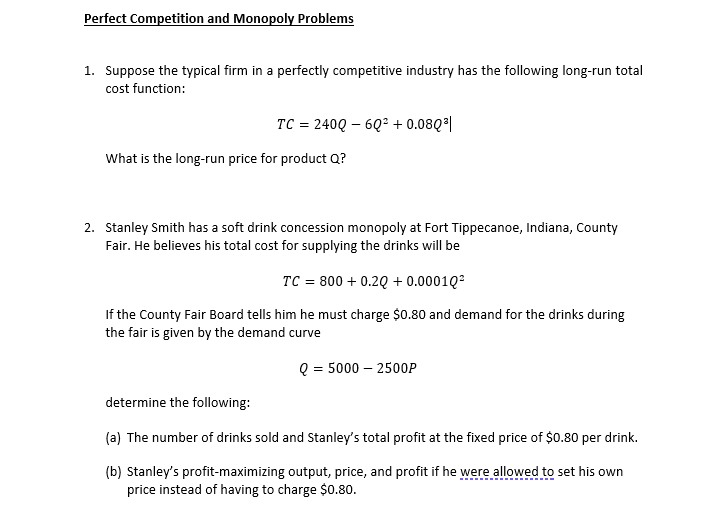1. Suppose the typical firm in a perfectly competitive industry has the following long-run total cost function: TC = 240Q – 6Q² + 0.08Qª| What is the long-run price for product Q?
1. Suppose the typical firm in a perfectly competitive industry has the following long-run total cost function: TC = 240Q – 6Q² + 0.08Qª| What is the long-run price for product Q?
Managerial Economics: Applications, Strategies and Tactics (MindTap Course List)
14th Edition
ISBN:9781305506381
Author:James R. McGuigan, R. Charles Moyer, Frederick H.deB. Harris
Publisher:James R. McGuigan, R. Charles Moyer, Frederick H.deB. Harris
Chapter11: Price And Output Determination: Monopoly And Dominant Firms
Section: Chapter Questions
Problem 4E
Related questions
Question

Transcribed Image Text:Perfect Competition and Monopoly Problems
1. Suppose the typical firm in a perfectly competitive industry has the following long-run total
cost function:
TC = 240Q – 6Q2 + 0.08Q*|
What is the long-run price for product Q?
2. Stanley Smith has a soft drink concession monopoly at Fort Tippecanoe, Indiana, County
Fair. He believes his total cost for supplying the drinks will be
TC = 800 + 0.2Q + 0.0001Q?
If the County Fair Board tells him he must charge $0.80 and demand for the drinks during
the fair is given by the demand curve
Q = 5000 – 2500P
determine the following:
(a) The number of drinks sold and Stanley's total profit at the fixed price of $0.80 per drink.
(b) Stanley's profit-maximizing output, price, and profit if he were allowed to set his own
price instead of having to charge $0.80.
Expert Solution
This question has been solved!
Explore an expertly crafted, step-by-step solution for a thorough understanding of key concepts.
This is a popular solution!
Trending now
This is a popular solution!
Step by step
Solved in 3 steps

Knowledge Booster
Learn more about
Need a deep-dive on the concept behind this application? Look no further. Learn more about this topic, economics and related others by exploring similar questions and additional content below.Recommended textbooks for you

Managerial Economics: Applications, Strategies an…
Economics
ISBN:
9781305506381
Author:
James R. McGuigan, R. Charles Moyer, Frederick H.deB. Harris
Publisher:
Cengage Learning



Managerial Economics: Applications, Strategies an…
Economics
ISBN:
9781305506381
Author:
James R. McGuigan, R. Charles Moyer, Frederick H.deB. Harris
Publisher:
Cengage Learning




Exploring Economics
Economics
ISBN:
9781544336329
Author:
Robert L. Sexton
Publisher:
SAGE Publications, Inc

Economics: Private and Public Choice (MindTap Cou…
Economics
ISBN:
9781305506725
Author:
James D. Gwartney, Richard L. Stroup, Russell S. Sobel, David A. Macpherson
Publisher:
Cengage Learning